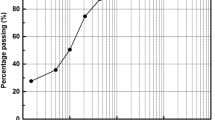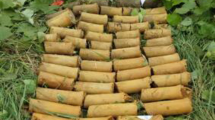Abstract
Black shale is widely distributed in southern and western China. The swelling and breakdown characteristics of black shale are important physicomechanical properties in engineering activities. Aqueous solutions with different compositions exert various influences on the swelling characteristic of black shale because of the complexity of its composition. Soils derived from black shale are most commonly developed on black shales with bedded horizons that generally have cutting and weathering profiles. This paper reports an axial free swelling study for soils derived from black shales and developed in the Lower Cambrian black shales in Chengkou County, Chongqing Municipality, Southwest China. To discuss the swelling characteristics of black shale under the influence of cations, an axial free swelling test was conducted on black shale samples while considering the initial water content, weathering stage of black shale, and different cationic solutions with various concentrations. Results showed that the swelling deformation curve of black shale could be divided into three phases: acceleration, deceleration, and stability. The axial swelling ratio eventually decreased with increasing water content, and the axial free swelling rate changed with the free expansion model of the exponential relationship. Under a constant initial water content, the axial swelling rate increased with the intensity of black shale weathering in the same immersion solution. When different types of immersion solutions were used, the cationic price was high and the axial swelling rate increased with rising cation valence. The changes in the swelling ratio were significant at a valence of one or two. The results of this study provide further understanding of the engineering geological characteristics of black shale and the geological hazards caused by the swelling characteristics of black shale.
Similar content being viewed by others
References
Bennett TH, Hulbert NH (1986) Clay microstructure. International Human Resources Development Corporation, Boston.
Blum JD, Erel Y (1997) Rb-Sr isotope systematics of a granitic soil chronosequence: The importance of biotite weathering. Geochimica et Cosmochimica Acta 61: 3193–3204.
Brumsack HJ (2006) The trace metal content of recent organic carbon-rich sediments: Implications for Cretaceous black shale formation. Palaeogeography Palaeoclimatology Palaeoecology 232: 344–361. DOI: 10.1016/j.palaeo.2005.05.011
Collins K (1984) Characterization of expansive soil microfabric. In: Proceedings of the 5th International Conference on Expansive Soils, Adelaide, Australia, 21-23 May, 1984. pp 37–41.
Chon HT, Cho CH, Kim KW, et al. (1996) The occurrence and dispersion of potentially toxic elements in areas covered with black shales and slates in Korea. Appl Geochem 11: 69–76.DOI: 10.1016/0883-2927(95)00061-5
Erel Y, Harlavan Y, Blum JD (1994) Lead isotope systematics of granitoid weathering. Geochimica et Cosmochimica Acta 58: 5299–5306. DOI: 10.1016/0016-7037(94)90313-1
Erel Y, Blum JD, Roueef E, et al. (2004) Lead and strontium isotopes as monitors of experimental granitoid mineral dissolution. Geochimica et Cosmochimica Acta 68: 4649–4663. DOI: 10.1016/j.gca.2004.04.022
Fang WX, Hu RZ, Wu PW (2002) Influence of black shales on soils and edible plants in the Ankang area, Shaanxi, P. R. China. Environ Geochem Health 24: 35–46. DOI: 10.1023/A:1013981016542
Fischer C, Gaupp R (2005) Change of black shale organic material surface area during oxidative weathering: Implications for rock-water surface evolution. Geochimica et Cosmochimica Acta 69: 1213–1224. DOI: 10.1016/j.gca.2004. 09.021
Gens A, Alonso EE (1992) A framework for the behaviour of unsaturated expansive clays. Canadian Geotechnical Journal 29: 1013–1032. DOI: 10.1139/t92-120
Harlavan Y, Erel Y (2002) The release of Pb and REE from granitoids by the dissolution of accessory phases. Geochimica et Cosmochimica Acta 66: 837–848. DOI: 10.1016/S0016-7037(01)00806-7
Harlavan Y, Erel Y, Blum JD (2009) The coupled release of REE and Pb to soil labile pool with time by weathering of accessory phases, Wind River Mountains, WY. Geochimica et Cosmochimica Acta 73: 320–336. DOI: 10.1016/j.gca.2008.11.002
Horan MF, Morgan JW, Grauch RI, et al. (1994) Rhenium and osmium isotopes in black shales and Ni-Mo-PGE-richsulfide layers, Yukon Territory, Canada, and Hunan and Guizhou province,China. Geochimica et Cosmochimica Acta 58: 257–265. DOI: 10.1016/0016-7037(94)90463-4
Hueckel TA (1992) Watermineral interaction in hygromechanics of clays exposed to environmental loads: a mixture-theory approach. Canadian Geotechnical Journal 29: 1071–1086. DOI: 10.1139/t92-124
Jaffe LA, Peucker-Ehrenbrink B, Petsch ST (2002) Mobility of rhenium, platinum group elements and organic carbon during black shale weathering. Earth and Planetary Science Letters 198: 339–353. DOI: 10.1016/S0012-821X(02)00526-5
Jin L, Mathur R, Rother G, et al. (2013) Evolution of porosity and geochemistry in Marcellus Formation black shale during weathering. Chemical Geology 356: 50–63. DOI: 10.1016/j. chemgeo.2013.07.012
Kennedy MJ, Pevear DR, Hill RJ (2002) Mineral Surface Control of Organic Carbon in Black Shale. Science 295: 657–660. DOI: 10.1126/science.1066611
Lee JS, Chon HT, Kim KW (1998) Migration and dispersion of trace elements in the rock-soil-plant system in areas underlain by black shales and slates of the Okchon zone, Korea. Journal of Geochemical Exploration 65: 61–78. DOI: 10.1016/S0375-6742(98)00054-5
Ling SX, Wu XY, Ren Y, et al. (2015) Geochemistry of trace and rare earth elements during weathering of black shale profiles in Northeast Chongqing, Southwestern China: Their mobilization, redistribution, and fractionation. Chemie der Erde 75: 403–417. DOI: 10.1016/j.chemer.2015.07.004
Ling SX, Wu XY, Sun CW, et al. (2016) Mineralogy and geochemistry of three weathered Lower Cambrian black shale profiles in northeast Chongqing, China. Geoscience Journal (online). DOI: 10.1007/s12303-016-0008-y
Littke R, Klussmann U, Krooss B, et al. (1991) Quantification of loss of calcite, pyrite, and organic matter due to weathering of Toarcian black shales and effects on kerogen and bitumen characteristics. Geochemica et Coschimica Acta 55: 3369–3378. DOI: 10.1016/0016-7037(91)90494-P
Olive WW, Chleborad AF, Frahme CW, et al. (1989) Swelling clays map of the conterminous United States. US Geological Survey Publication, USGS, USA.
Pašava J, Kríbek B, Zak K (2003) Preliminary results of the study of toxic elements in soils and crop plants in areas of Ni-Mo black shale-hosted deposits (Zunyi region, south China). In: D. Eliopoulos et al. (eds.), Mineral exploration and sustainable development. Millpress, Rotterdam.
Peng B, Tang XY, Yu CX, et al. (2009) Geochemical study of heavy metal contamination of soils derived from black shales at the HJC uranium mine in Central Hunan, China. Acta Geol Sinica 83: 89–106. (In Chinese)
Peng B, Rate A, Song ZL, et al. (2014) Geochemistry of major and trace elements and Pb–Sr isotopes of a weathering profile developed on the Lower Cambrian black shales in central Hunan, China. Applied Geochemistry 51: 191–203. DOI: 10.1016/j.apgeochem.2014.09.007
Salmon V, Derenne S, Lallier-Vergès E, et al. (2000) Protection of organic matter by mineral matrix in a Cenomanian black shale. Organic Geochemistry 31: 463–474. DOI: 10.1016/S0146-6380(00)00013-9.
Stepkowska ET (1990) Aspects of the clay/electrolyte/water system with special reference to the geotechnical properties of clays. Engineering Geology 28: 249–268. DOI: 10.1016/0013-7952(90)90011-O
Tang XY, Peng B, Yu CX, et al. (2009) Elemental Geochemistry of Soils Derived from the Lower-Cambrian Black Shales in Anhua County, central Hunan, China. Acta Sci Circumstantiae 29: 2623–2634. (In Chinese)
Tourtelot EB (1979) Black shale—its deposition and diagenesis. Clays and Clay Minerals 27: 313–321.
Tuttle MLW, Breit GN (2009) Weathering of New Albany shale, Kentucky, USA: I. Weathering zones defined by mineralogy and major-element composition. Applied Geochemistry. 24: 1549–1564. DOI: 10.1016/j.apgeochem.2009.04.021
Tuttle MLW, Breit GN, Goldhaber MB (2009) Weathering of New Albany shale, Kentucky. II: redistribution of minor and trace elements. Applied Geochemistry 24: 1565–1578. DOI: 10.1016/j.apgeochem.2009.04.034
Wenger LM, Baker DR (1986) Variations in organic geochemistry of anoxic-oxic black shale-carbonate sequences in the Pennsylvanian of the Midcontinent, U.S.A. Organic Geochemistry 10: 85–92. DOI: 10.1016/0146-6380(86)90011-2
Wong RCK. (1998) Swelling and softening behaviour of La Biche shale. Canadian Geotechnical Journal 35: 206–221. DOI: 10.1139/t97-087
Wu XY, Ling SX, Ren Y, et al. (2016) Elemental migration characteristics and chemical weathering degree of black shale in northeast Chongqing, China. Earth Science 41(2): 218–233. (In Chinese) DOI: 10.3799/dqkx.2016.017
Xie SR, Peng B, Tang XY, et al. (2007) Environmental geochemistry of the waste rock dump in the Taojiang manganese deposit, Hunan, China. Geol Bull China 26: 333–343. (In Chinese)
Xu JZ, Peng B, Yu CX, et al. (2013) Geochemistry of soils derived from black shales in the Ganziping mine area, western Hunan, China. Environmental Earth Science. 70: 175–190. DOI: 10.1007/s12665-012-2114-0
Yu CX, Peng B, Peltola P, et al. (2012) Effect of weathering on abundance and release of potentially toxic elements in soils developed on Lower Cambrian black shales, P. R. China. Environmental Geochemistry and Health 34: 375–390. DOI: 10.1007/s10653-011-9398-y
Zhu BL, Li XN, Wu XY, et al. (2015) Experimental study of micro-characteristics of swelling for black shale under influence of water. Chinese Journal of Rock Mechanics and Engineering 34: 3896–3905. (In Chinese)
Wan Y, Gong B, Li DQ (1996) The study of dehydration in ionexchanged montmorillonite. Chemical Research and Application 8(1): 52–57. (In Chinese)
Author information
Authors and Affiliations
Corresponding author
Additional information
http://orcid.org/0000-0002-7188-2720
http://orcid.org/0000-0003-0517-1100
http://orcid.org/0000-0003-0760-9049
Rights and permissions
About this article
Cite this article
Li, Xn., Zhu, Bl. & Wu, Xy. Swelling characteristics of soils derived from black shales heightened by cations in Northern Chongqing, China. J. Mt. Sci. 13, 1107–1119 (2016). https://doi.org/10.1007/s11629-015-3576-9
Received:
Revised:
Accepted:
Published:
Issue Date:
DOI: https://doi.org/10.1007/s11629-015-3576-9




